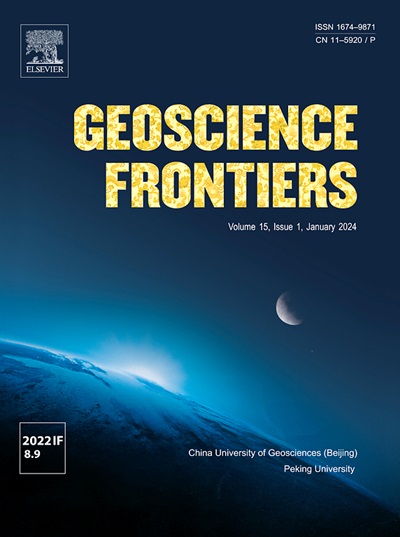A plate geodynamic game changer: Effects of the 66 Ma Chicxulub asteroid collision
IF 8.9
1区 地球科学
Q1 GEOSCIENCES, MULTIDISCIPLINARY
引用次数: 0
Abstract
At the end of the Cretaceous period, 66 million years ago, the 7 − 19 km diameter Chicxulub asteroid hit the Yucatan Peninsula in Mexico, triggering global catastrophic environmental changes and mass extinction. The contributions of this event towards changes in plate and plume geodynamics are not fully understood. Here we present a range of geological observations indicating that the impact marked a tectonic turning point in the behavior of mantle plume and plate motion in the Caribbean region and worldwide. At a regional scale, the impact coincides with the termination of seafloor spreading in the Caribbean Ridge. Shortly after the Cretaceous–Paleogene transition, magmatism associated with the Caribbean Large Igneous Province waned, and intensive Paleogene volcanism was initiated. These events happened synchronously with anomalously high mid-ocean ridge magmatism worldwide and an abrupt change in the relative motion of the South American and North American tectonic plates. The evidence for such abrupt changes in plate kinematics and plume behavior raises the possibility that the Chicxulub impact triggered a chain of effects that modified melt reservoirs, subducting plates, mantle flows, and lithospheric deformation. To explain how an asteroid impact could modify tectonic behavior, we discuss two end-member mechanisms: quasi-static and dynamic triggering mechanisms. We designed a numerical model to investigate the strain field and the relative plate motion before and after the impact. The model predicts an enhanced deformation associated with the impact, which surficially tapers off ∼ 500 km from the crater. The impact modifies the subjacent mantle flow field, contributing to long-term mantle-driven dynamic changes. Additionally, deformation associated with seismic effects may have contributed to far-field effects and global changes. We conclude that large asteroid impacts, such as the Chicxulub collision, could trigger cascading effects sufficient to disrupt and significantly modify plate geodynamics.

板块地球动力学游戏改变者:66 Ma希克苏鲁伯小行星碰撞的影响
在6600万年前的白垩纪末期,直径7 - 19公里的希克苏鲁伯小行星撞击了墨西哥的尤卡坦半岛,引发了全球灾难性的环境变化和大规模灭绝。这一事件对板块和地幔柱地球动力学变化的贡献尚不完全清楚。在这里,我们提出了一系列的地质观测,表明这次撞击标志着加勒比海地区和全世界地幔柱和板块运动行为的一个构造转折点。在区域范围内,这种影响与加勒比海脊海底扩张的终止相吻合。白垩纪-古近纪过渡后不久,与加勒比海大火成岩省有关的岩浆活动减弱,古近纪火山活动开始强烈活动。这些事件与全球洋中脊异常高岩浆活动以及南美和北美构造板块相对运动的突变同步发生。关于板块运动和地幔柱行为的这种突变的证据提出了这样一种可能性,即希克苏鲁伯撞击引发了一系列影响,这些影响改变了熔体储层、俯冲板块、地幔流和岩石圈变形。为了解释小行星撞击如何改变构造行为,我们讨论了两种端元机制:准静态触发机制和动态触发机制。我们设计了一个数值模型来研究碰撞前后的应变场和相对板块运动。该模型预测了与撞击相关的增强变形,表面上从陨石坑约500公里处逐渐减少。撞击改变了下地幔流场,形成了地幔驱动的长期动态变化。此外,与地震效应相关的变形可能导致远场效应和全球变化。我们得出的结论是,大型小行星撞击,如希克苏鲁伯碰撞,可能引发级联效应,足以破坏并显著改变板块地球动力学。
本文章由计算机程序翻译,如有差异,请以英文原文为准。
求助全文
约1分钟内获得全文
求助全文
来源期刊

Geoscience frontiers
Earth and Planetary Sciences-General Earth and Planetary Sciences
CiteScore
17.80
自引率
3.40%
发文量
147
审稿时长
35 days
期刊介绍:
Geoscience Frontiers (GSF) is the Journal of China University of Geosciences (Beijing) and Peking University. It publishes peer-reviewed research articles and reviews in interdisciplinary fields of Earth and Planetary Sciences. GSF covers various research areas including petrology and geochemistry, lithospheric architecture and mantle dynamics, global tectonics, economic geology and fuel exploration, geophysics, stratigraphy and paleontology, environmental and engineering geology, astrogeology, and the nexus of resources-energy-emissions-climate under Sustainable Development Goals. The journal aims to bridge innovative, provocative, and challenging concepts and models in these fields, providing insights on correlations and evolution.
 求助内容:
求助内容: 应助结果提醒方式:
应助结果提醒方式:


